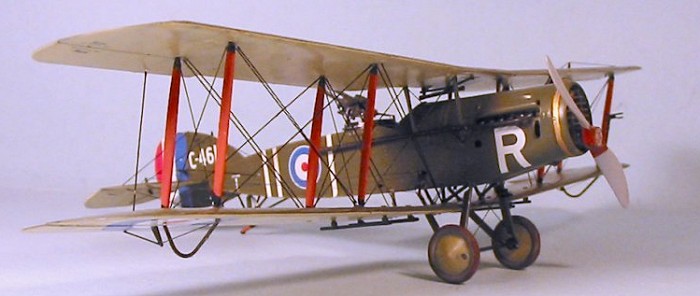
| KIT: | Eduard 1/48 Bristol F.2B |
| KIT #: | ? |
| PRICE: | $39.98 MSRP |
| DECALS: | 4 options |
| REVIEWER: | Tom Cleaver |
| NOTES: |

| HISTORY |
Known simply as The Bristol Fighter, designer Frank Barnwell's two‑seater more than lived up to its name during the last eighteen months of the First World War, from which it emerged as the best Allied two‑seater of the conflict.
While most of its contemporaries soon ended on the scrap heaps, the F.2B went continued in production after the war, and was the mainstay aircraft of the newly‑formed RAF for the next 14 years, as it maintained order on the far‑flung edges of the British Empire.
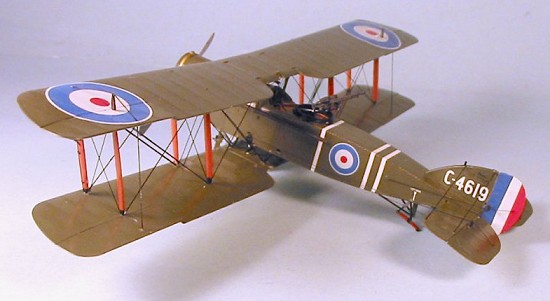 The Royal Flying Corps went to war in 1914 equipped with the B.E.2 series
of two‑seaters. By the time of the Somme Battle in 1916, the Royal Aircraft
Factory - maker of the B.E. series - had come up with the R.E.8 as a
replacement. While this airplane at least got the seating arrangements
right, with the gunner in back, and the cockpits close together to
facilitate communication, the airplane was little better performance‑wise
than what it was designed to replace. The R.E.8, affectionately known as
"'Arry Tate," served as the primary Corps reconnaissance aircraft for the
The Royal Flying Corps went to war in 1914 equipped with the B.E.2 series
of two‑seaters. By the time of the Somme Battle in 1916, the Royal Aircraft
Factory - maker of the B.E. series - had come up with the R.E.8 as a
replacement. While this airplane at least got the seating arrangements
right, with the gunner in back, and the cockpits close together to
facilitate communication, the airplane was little better performance‑wise
than what it was designed to replace. The R.E.8, affectionately known as
"'Arry Tate," served as the primary Corps reconnaissance aircraft for the
remainder of the war, but its performance was such that the casualty rate among its crews was little less than that experienced by their "Fokker Fodder" forebears.
At the same time, Captain Frank Barnwell, chief designer of the British & Colonial Aeroplane Co., Ltd. ‑ later known as Bristol Aeroplane Co., Ltd. ‑ was involved in the development of a potential replacement for the B.E. His first design, the R.2A, was powered by a 120 h.p. Hispano‑Suiza engine. This was quickly replaced by the R.2B, with a Hispano‑Suiza powerplant uprated to 150 h.p.
The arrival of the Rolls‑Royce Falcon engine of 190 h.p., and the delivery by Vickers of the Constantinescu gun‑ synchronizing mechanism, attracted Barnwell's attention; he redesigned the R.2 airframe to take the additional horsepower,
installing a forward‑firing Vickers machine gun on the centerline, which had the advantage of keeping the gun warm with the engine, and jams could easily be cleared since the cocking handle was inside the cockpit. The new design was re‑designated the F.2A to reflect its new "fighter" concept, and the first prototype flew on September 9, 1916, with 50 already on order. Once a faulty altimeter was replaced, it was discovered the airplane could climb to 10,000 ft. in 15 minutes, which was startling performance for its day; further testing revealed the airplane was as maneuverable as a single‑seat fighter (though not in the Sopwith class). The F.2B entered production in November 1916. Demand was so strong that subcontractors were brought into the program, and the airplane was eventually built by Austin Motors Co.; Sir W.G. Armstrong‑Whitworth & Co., Ltd.; Gloucestershire Aircraft Co.; Harris & Sheldon, Ltd.; Marshall & Sons; the National Aircraft Factory No. 3;, Angus, Sanderson & Co.; and Standard Motor Co., Ltd. The 275 h.p. Falcon III began to power the fighter in July 1917.
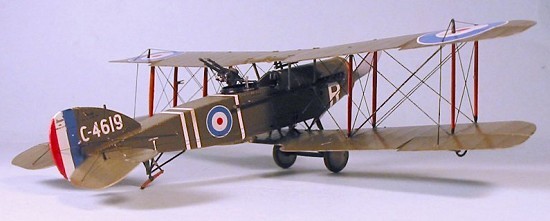 The first squadron to equip on the type and take the Bristol Fighter into
action was 48 Squadron, RFC. On April 5, 1917, six F.2Bs led by Captain
Leefe Robinson, VC, were intercepted by Albatros D.IIIs of Jasta II,
personally led by Manfred von Richtofen. Handling the airplane like a
standard two‑seater, the formation was badly mauled, with only two
returning from the mission, and those badly damaged. Leefe Robinson
himself was shot down and made a Prisoner of War.
The first squadron to equip on the type and take the Bristol Fighter into
action was 48 Squadron, RFC. On April 5, 1917, six F.2Bs led by Captain
Leefe Robinson, VC, were intercepted by Albatros D.IIIs of Jasta II,
personally led by Manfred von Richtofen. Handling the airplane like a
standard two‑seater, the formation was badly mauled, with only two
returning from the mission, and those badly damaged. Leefe Robinson
himself was shot down and made a Prisoner of War.
Events took a dramatic turn for the better shortly thereafter when the pilots began flying the airplane like a fighter, with the gunner there to take care of the rear while they went after the target. On April 30, six aircraft fought their way back from Douai without loss. The airplane became affectionately known to its crews as the "Biff."
“Bull” Staton - the third-ranking Biff ace:
The combat career of Captain William Ernest “Bull” Staton - from his first victory on March 12 1918 at the outset of the German 1918 Offensive, through his being wounded badly enough to be sent back to England on September 24, 1918 - is exemplary of what a good pilot could achieve with the Bristol Fighter. During this period, Staton destroyed 19 enemy aircraft and shot down another 7 out of control for a total of 26 victories, making him the third-ranked Bristol Fighter Ace after Keith Park and Andrew McKeever. Proof that the Bristol was indeed a “2 seat fighter” is the fact that his gunner, Lt. Horace Ernest Meritt, who flew with Staton from March 13 to June 24, 1918, scored 9 victories, becoming one of the 35 “gunner aces” in Bristol Fighters.
62 Squadron was formed on July 20, 1916 as a training squadron. In March 1917 it was changed to a service squadron, and was equipped with Bristol Fighters that summer. Several times the unit was alerted for transfer to France, with the orders being rescinded at the last minute. This allowed the unit to become very proficient with their aircraft. 62 Squadron finally arrived in France on January 1, 1918 and was posted to the Cambrai Front, where they were declared operational in the first week of March, 1918. Within days, the great German offensive of 1918 would bring them into nearly-continuous combat until the end of the war.
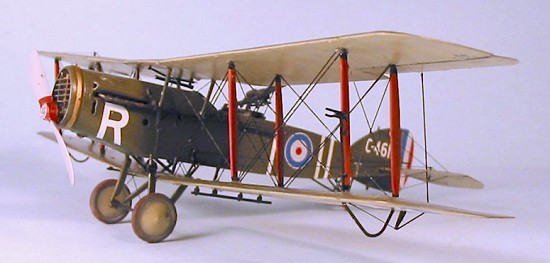 On March 12, the squadron first met Jasta 11 of Jagdgeschwader 1,
personally led by Manfred von Richtofen. The Germans lost three fighters
against one Bristol Fighter, one of the Germans being credited to “Bull”
Staton. The next day, again flying against the Richtofen Circus, Staton
shot down three German fighters including a Fokker Triplane.
On March 12, the squadron first met Jasta 11 of Jagdgeschwader 1,
personally led by Manfred von Richtofen. The Germans lost three fighters
against one Bristol Fighter, one of the Germans being credited to “Bull”
Staton. The next day, again flying against the Richtofen Circus, Staton
shot down three German fighters including a Fokker Triplane.
Staton quickly became the “star” of 62 Squadron and had a reputation as a fearless pilot who would attack without the slightest hesitation, even when outnumbered. Throughout the summer and fall of 1918, 62 Squadron’s main opponents were the renowned Richtofen Geschwader.
Staton was known to be entirely oblivious to personal danger, on many occasions flying straight at a German fighter, zooming at the last second to avoid collision. He was an exceptional shot with his machine gun. When he shot down a Fokker D.VII on September 15, the official report on the captured aircraft provided praise for the remarkable accuracy of the shooting that brought it down.
Staton was wounded in the leg by an explosive bullet, in a combat east of Cambrai on September 24, 1918. On being discharged from hospital, he tried to be reassigned to the squadron, but the Armistice was signed before he could return to combat.
By the end of the war, 62 Squadron was credited with destroying 78 enemy aircraft and shooting down an additional 85 out of control. Staton was personally responsible for one-fourth of those destroyed in the air and close to one in ten of those shot down out of control. Remaining in the RAF post-war, Staton rose to the rank of Air Vice Marshal during the Second World War.
| THE KIT |
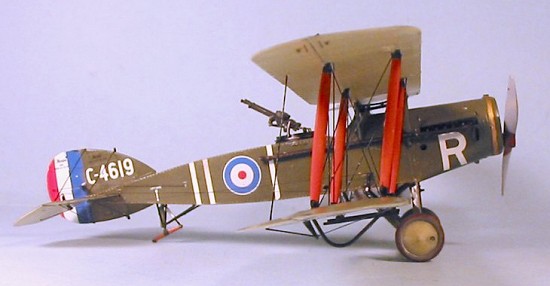 The first 1/48 Bristol Fighter kit was produced by Aurora in the late
1950s, and was the only Brisfit kit available for close to 40 years. Blue
Max and Aeroclub both brought out limited-run kits of the airplane in
1999. The first “mainstream” 1/48 Brisfit since the Aurora kit of the
1950s was released by Roden in late 2003.
The first 1/48 Bristol Fighter kit was produced by Aurora in the late
1950s, and was the only Brisfit kit available for close to 40 years. Blue
Max and Aeroclub both brought out limited-run kits of the airplane in
1999. The first “mainstream” 1/48 Brisfit since the Aurora kit of the
1950s was released by Roden in late 2003.
Eduard’s Bristol Fighter, released this summer, is a good example of how far this company has come from its early days as a manufacturer of limited-run kits. In terms of production quality and design, it is the equal of anything released by Tamiya or Hasegawa. While it could not be considered a “shake ‘n’ bake” kit in terms of assembly, it is designed to be much less difficult to build than the more “fiddly” Roden kit. The Roden kit, which is less than half the price of this kit by Eduard, is not eclipsed in detail by this newer release. In fact, to my eye, Roden has a more accurate representation of fabric wing detail than this kit has. The Eduard kit has prominent rib tapes that would be nearly 1 inch thick in full scale, in a manner similar to that of their Sopwith Camel kits. However, like the Camel, this surface detail looks all right under a coat of paint.
Decals are provided for four different airplanes, including the Bristol Fighter flown by “Bull” Staton in 62 Squadron.
| CONSTRUCTION |
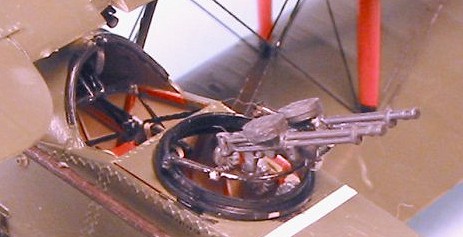 As is usual with a model, construction begins with the cockpit. While this
“non-Profipack”version does not have the wealth of small detail in
photo-etch that the more expensive version has, the result is very
acceptable. The fact that the fuselage halves are one-piece, without the
separate cowling like the Roden kit, makes for an easy assembly. The kit
instructions are clear and easy to follow.
As is usual with a model, construction begins with the cockpit. While this
“non-Profipack”version does not have the wealth of small detail in
photo-etch that the more expensive version has, the result is very
acceptable. The fact that the fuselage halves are one-piece, without the
separate cowling like the Roden kit, makes for an easy assembly. The kit
instructions are clear and easy to follow.
While the fuselage was setting up, I attached the separate ailerons and elevators to the wings and horizontal stabilizer. Once all this was done, it was time to proceed to paint and decals.
| COLORS & MARKINGS |
Painting:
After pre-shading the model with flat black, I painted the lower surfaces with Gunze-Sangyo “Sail Color” and the upper surfaces with Gunze-Sangyo “RAF Dark Green.” the struts were painted with a mixture of gloss yellow and brown to simulate “Ash”. When dry, the model was given a coat of Future.
Decals:
Kit decals were used and went down without difficulty. When the decals had set, the model was washed and then given an overall coat of Xtracrylix Satin Varnish.
| FINAL CONSTRUCTION |
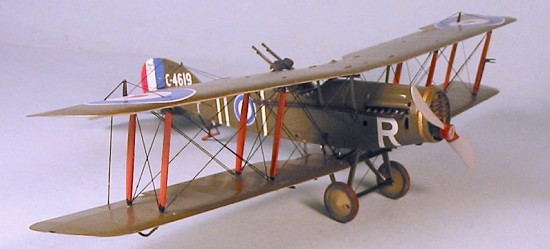 The big problem in all other Bristol Fighter models is the fact that the
lower wing is separated from the fuselage and attached with small struts.
Eduard has designed the landing gear to include the main struts on either
side, so that all one has to do is assemble the landing gear to the lower
wing, and then attach this sub-assembly to the fuselage. After super-gluing
the cabane struts in position, I attached the upper wing, then attached the
interplane struts with cyanoacrylate glue.
The big problem in all other Bristol Fighter models is the fact that the
lower wing is separated from the fuselage and attached with small struts.
Eduard has designed the landing gear to include the main struts on either
side, so that all one has to do is assemble the landing gear to the lower
wing, and then attach this sub-assembly to the fuselage. After super-gluing
the cabane struts in position, I attached the upper wing, then attached the
interplane struts with cyanoacrylate glue.
Rigging:
All British World War I airplanes seem to have more complex rigging than do either French or German aircraft. While not a “bird cage” in comparison with the D.H.2 or the F.E.2b, the rigging for the Bristol Fighter is complex. As usual, the secret is to take one's time. I used .008 wire painted gloss black for this, and attached it with cyanoacrylate glue to make the bracing structural and add to the rigidity of the final model.
| CONCLUSIONS |
Having built all the various 1/48 kits of the Bristol Fighter, I can say that this one from Eduard is the easiest to assemble. While it is far less “fiddly” than the Roden kit, the end result is not that much more detailed than the Roden kit, which is - as mentioned - almost half as expensive as this kit. However, for modelers who are making their first forays into building World War I models, and particularly for the more advanced (read difficult) models like the Bristol Fighter or the Camel, Eduard’s kit design is less-daunting and more likely not to create problems for newcomers to the genre. On that alone, I would say the kit is good value for money since it will bring new modelers to the field of World War I modeling.
August 2005
Thanks to Eduard for the review kit.
If you would like your product reviewed fairly and quickly by a site that has around 300,000 visitors a month, please contact me or see other details in the Note to Contributors.